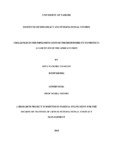| dc.description.abstract | Responsibility to Protect doctrine adoption and application was due to mass atrocities against various populations. This study, therefore, evaluated the challenges that the African Union faces in human rights protection through the implementation of the doctrine. The study provided an overview of the doctrine and its application in various African conflicts. The theoretical framework used in this study was Krasner’s international regime theory. This theory helped to understand that power is devolved amongst existing institutions which operate as implicit coalitions based upon principles, norms, rules and decision-making procedures all working towards desirable outcomes. Mixed method research was used in the study and the primary data was collected by use of questionnaires, a sample size of 100 was selected by the researcher using purposive sampling. The researcher used her own judgment in selecting the target population with practical knowledge on the subject. The findings of the study include: (a) the African Union implementation of the Responsibility to Protect in protecting its population against the atrocity crimes, (40.24% n=33) of the respondents renounced that the doctrine is significant in resolving African conflicts (b) the respondents agreed that the AU has established various mechanisms to uphold human rights, (48.78% n=40) indicated the AU was highly effective in legislative formulation, that the Union was effective in institutional establishment (45.12% n=37) and structural establishment was effective with (46.34% n=38) and had not borne the intended results (c) it was evident that the AU faces significant challenges in the achievement of human rights in Africa, through the implementation of the R2P doctrine hence the ineffectiveness with (48.78% n=40) and highly ineffective (15.85% n=13). An indication of inadequate resources, lack of political will, bottlenecked decision-making processes, justification and execution of the doctrine, ASF’s capability and the use of nascent norms to ongoing conflicts were some of the discussed challenges. The study finally recommends that the population should be involved in conflict mitigation and human rights protection, the AU should address the procedural flaws in the decision making process and approach each conflict individually, the international community should adopt the ICISS recommendations and early warning mechanism while scaling up the application of the R2P doctrine in cases atrocity crimes’ commission to uphold human rights and maintenance of universal peace and security. | en_US |



